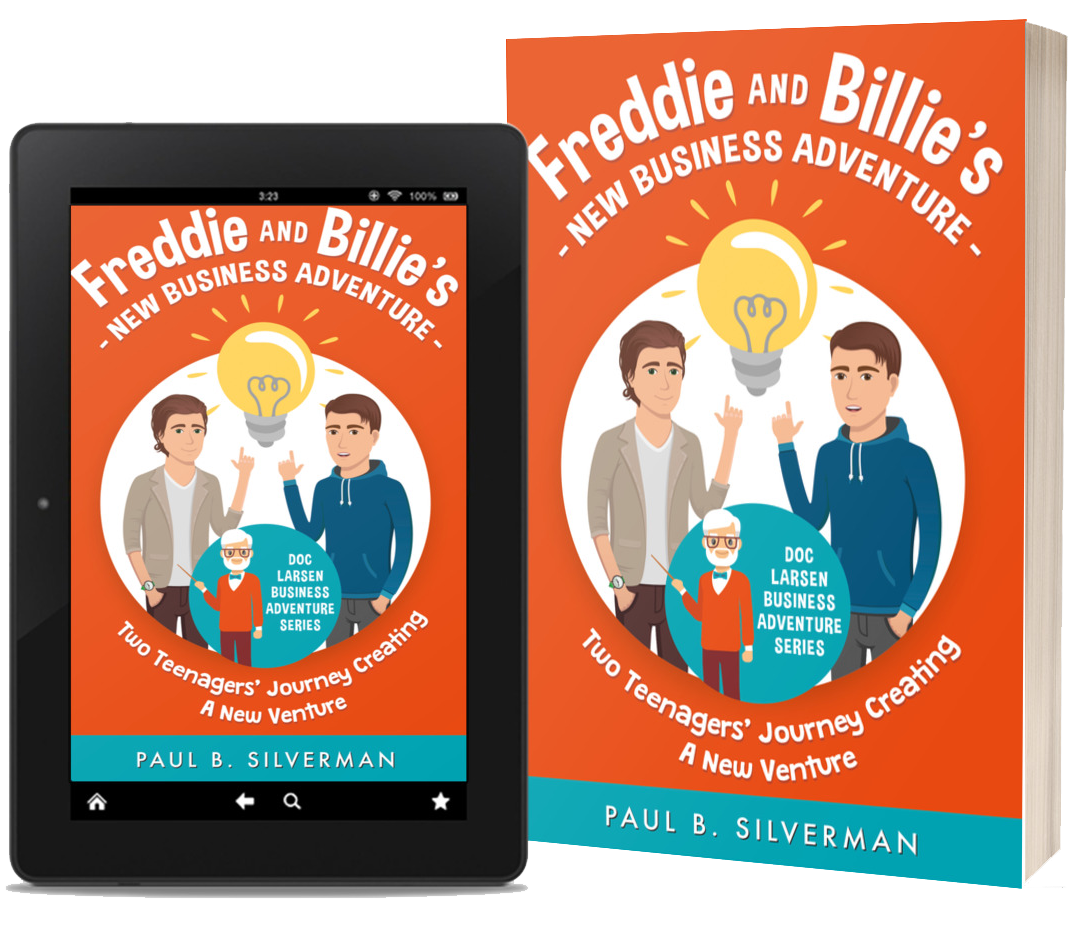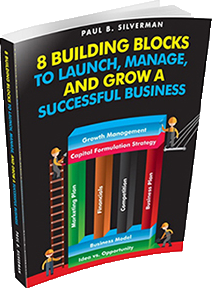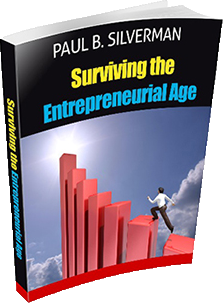Freddie and Billie’s New Business Adventure
Two Teenagers’ Journey Creating a New Venture
Book Excerpts:
- Chapter 8 Models, Schmodels, Doc – What’s Really In The Box
- A Message for Young Aspiring Entrepreneurs: This Book is Written For You
Chapter 8
Models, Schmodels, Doc – What’s Really In The Box?
We finished our break and headed back to the study. Mitch looked happier than usual and Doc and I knew why. Part of Freddie’s donut ‘accidentally’ fell to the floor and Mitch’s ‘donut radar’ picked it up, probably before it hit the floor.
When Mitch looked at Freddie with that ‘…excuse me, are you really going to eat that look?’, we know what would happen next. Really great dog and amazing how he bonded with Freddie.
Freddie wanted to say something and clearly looked bothered. “Doc, I really appreciate you taking the time to work with us and help us plan and launch our Zinger venture, but I am feeling like ‘models, schmodels’, and we are drilling down on fruits and vegetables. Just hope this is not an academic exercise and sorry, but just don’t see how supermarket shopping relates to our Zinger business. See my concern, Doc?”
“Absolutely see your concern and understand,” said Doc.” I suggest just be patient – you will see how this all fits together and how we will use these techniques to plan and launch the Zinger business. Trust me,” said Doc.
As I said before, those were words Freddie and I would hear many times.
We settled back into the study and Doc pointed us to a flip chart in the corner of the room. Pulling the chart to the center of the room, he turned over the first blank sheet and the following large diagram covered the page.
“So now step back and look at the box diagram. Here is our starting point. Materials come into the business ‘box’ with money to launch and support the business. Finished products come out with money coming back in from sales. And if you are successful, profits come out. And think about it – this simple Business in a BoxTM structure applies to all businesses.
Pretty simple concept to understand – important first step to understand how business works,” said Doc.
“Now let’s move on to answer the question ‘What’s In The Box?’,” said Doc, as he turned to the next flip page chart and showed the following:
“What you see are seven models all linked together as shown. Think of these models as parts of a ‘business machine’ which shows how all parts of the business work and fit together.
And what you see on the board applies to all companies, large and small, established companies and new ventures. For some businesses, such as the Zinger business, we may not use all the models shown initially, but may need more as the business grows.
Here is a summary of what you see here:
- The Business Model
- The Market Model
- The Financial Model
- The Scorecard Model
- The Production Model
- The IN and OUT Model
- The People Model
When we are done, you will understand these models; how they work, how they relate and link together – you will also be well equipped to develop your Zinger business and address the many business decisions you will need to make.”
I could see Freddie was getting agitated – known him long enough and can see an “Uh-Oh” moment coming. And it was.
“Doc, with all due respect, ‘models, schmodels’ – this looks awfully complicated – we are just making a fishing jig and seems to me like a basic business: buy parts, assemble, sell, and make a profit. Here is how I see the model of our business, simple:
Sales-Costs = Profits
Our strategy is to grow sales, keep costs low and create profit for us. So, what’s wrong with my thinking Doc, what am I missing here?”
Doc’s response to Freddie consisted of words he had delivered many times before. I know because I looked up several of his many publications – same message.
It is seductively simple to believe that launching and growing a new sustainable and defensible business is as simple as following the above three-line formula. Statistics show half of all new ventures fail within three years and two-thirds fail within five years. Much easier to start a new business than to keep it going.
The seven model structure shown is a powerful tool to review the basics and help you plan and launch a sustainable and defensible new business.
Note the two words I slipped in. First – ‘sustainable’, meaning there is a path to create more sales beyond initial orders; suppliers can meet increased demand as business grows; your production facilities can expand to support growth – many businesses often fail due to inability to meet growth targets while managing costs. And that takes planning.
And the second word I slipped in was ‘defensible’ – how do you respond to competitive challenges; if a competitor offers a similar product priced at 20 percent below the Zinger, can you respond while maintaining a profit? What are your plans to move beyond the initial Zinger product to grow and establish a market niche, maybe develop a Zinger jig ‘product family’, tie in with other fishing tackle manufacturers, etc? These and similar questions are typical of what you need to address, particularly in high-growth competitive markets. ‘Sustainable and defensible’ mean survival – really critical point here.
Both Freddie and I were impressed – didn’t know exactly where we were heading in our ‘entrepreneurial journey’ but we obviously had a solid navigator and we were willing to work hard to flesh out the new Zinger product, launch and grow the business. I felt better about the ‘trust me’ words.
But Freddie still had a questioning look, usually meaning ‘… I think I understand what someone is saying, sort of, sounds interesting, let’s see where this goes.
Doc continued. “Before we go further here, I’d like to share with you what I call the golden rule for launching a new business.”
“I know that one, Doc,” said Freddie – “… he who owns the gold rules.” Freddie was pleased with his answer.
“Very good Freddie, but that’s not the golden rule I am talking about – this is:
The traditional laws of business are not repealed for new ventures. Understanding and applying these traditional rules and avoiding the ‘paralysis by analysis’ challenge can help launch a new business and improve probability of success.’ We will talk more about this in a future session.
And answering the What’s In The Box? question will give you a good start helping you follow the ‘golden rule’.”
Next week we will drill down on the Financial and Market Models, two of the most important Business in a BoxTM models for understanding the Zinger business.
Let’s break for today. Look forward to seeing you both next week.”
We said goodbye to Doc, petted Mitch, and headed home.
Doc had covered a lot of ground in that session and I had the feeling, now that he had introduced us to the What’s In The Box basics, he would be ramping up and pushing us further. And I was right – as you will see, we were in for an exciting ride in the coming weeks with many ups and downs.
========================================================
A Message for Young Aspiring Entrepreneurs: This Book is Written For You
I created the Doc Larsen Business Adventure Series to introduce young adult readers like you to entrepreneurship. Helping you understand how you plan, develop, launch and manage a new business is my objective. So why is this important?
Many reasons – here are my top four:
- Entrepreneurship teaches you valuable new skills; improves your creative thinking and problem-solving abilities; helps you identify opportunities and evaluate solutions; improves your understanding of how business works and how parts fit together to create sales and value for owners.
- Entrepreneurial management skills provide you with tools that help you excel even if you never start a new business. Whether you major in business, engineering, art, healthcare, journalism, or any discipline, learning how to think entrepreneurially will help you in your career. Trust me on this one.
- New business opportunities are growing exponentially fueled by new technology, new markets, and new ways of doing business. What is less well known is that many of these are pursued by small and emerging companies. Statistics today show companies with less than 500 employees account for 97 percent of all new jobs. Smaller, innovative companies not Fortune 500 companies, drive today’s entrepreneurial revolution, offering high rewards for entrepreneurs. Having entrepreneurial skills provides you with a competitive edge entering the job market or seeking to advance your career.
- Many of today’s leading companies were started by young entrepreneurs. Apple® was started in a Cupertino, California garage by founders Steve Jobs and Steve Wozniak on April 1, 1976. And Dell®, Microsoft®, Home Depot®, Amazon.com®, Starbucks®, and many others were launched by younger entrepreneurs in the past 35 years. Many young entrepreneurs want to create new industries or disrupt existing ones to create wealth and do their own thing.
The Doc Larsen Business Adventure series is designed to spur young adult interest in entrepreneurship and provide new skills to help them evaluate business ideas and create successful new business ventures.
The first book in the Doc Larsen Business Adventure series, Freddie and Billie’s New Business Adventure, introduces young adult readers like you to a streamlined, structured, easy to explain Business In A BoxTM planning system I developed to help young readers define a business opportunity and develop market, business and financial models and business plans to launch a new venture.
The Business In A BoxTM system includes seven integrated models. Each model is easy to explain, and it is easy to understand how these fit together to plan the business. Understanding how new ventures are developed typically demands a textbook approach, reviewing business models, marketing, and strategy, and this can be overwhelming. I have taught many entrepreneurship courses at both undergraduate and graduate levels using sophisticated modeling tools and is currently teaching a senior level entrepreneurship course at George Mason University. I created the Business In A BoxTM to help young adult entrepreneurs plan, develop, and launch a new business.
In Freddie and Billie’s New Business Adventure you will be introduced to two teenagers, Billie Phillips and Freddie Lampert (Billie and Freddie), high school seniors, seeking to develop a new fishing jig but ‘…knowing zilch about business’. The teenagers learn how to plan, launch, and manage their new venture, and turn their idea into an opportunity – that is the journey you will take in Freddie and Billie’s New Business Adventure. Weekly meetings with mentor Dr. Ralph Larsen, or ‘Doc’, and his constant companion, Mitch, described as the ‘droolingest’ St. Bernard they ever saw, and storytelling techniques are the vehicles I use to share the skills needed to plan and launch a new venture.
My views are shaped by four decades of senior management and management consulting experience, teaching entrepreneurship and strategy management courses to senior and MBA college students since 2002, and working with hundreds of early stage companies. I can assure you, entrepreneurship skills can be learned.
I hope you enjoy the adventure you will take with Billie and Freddie and that the book helps you on your entrepreneurial adventures wherever they may take you.
Paul B. Silverman
March 2020
==============================================================
==============================================
8 Building Blocks To Launch, Manage, And Grow A Successful Business (June 2015)
Excerpt From
Building Block 3: Marketing Plan (Page 62)
Four Key Elements in the Marketing Plan
Formats vary widely, but for our purposes let’s review the following four key elements in all Marketing Plans: Defining Your Business; Total Size of Available Market; Addressable and Addressed Markets; and Market Share. Each of these components is discussed below.
– Defining Your Business
You need to define exactly what are you selling and who are your customers. This sounds obvious, but it is an easy mistake to make as you develop your business. The following example should make this clear.
Worldwide Widget Corporation is developing AlphaFinancialAnalyzer, a new financial analysis tool. The product targets professionals interested in using powerful mobile-based stock market analytics to improve their portfolio performance.
That is a reasonable, high-level, definition of your business. You can identify specific competitive products, assess market size, and so on.
But suppose you have several other financial products and see an opportunity to launch a “financial supermarket” offering several other products; maybe a retirement planner, lifestyle management tool and others that you feel would broaden your market.
You may be right; you will broaden the market but remember, for investors you need to define exactly what business you are in. And what I described here are really two different businesses which drive different market projections, strategies, and business models. For example, pursuing the focused product strategy defined above you can secure major channel partners, ….
===========================================================
Excerpt From
Building Block 3: Marketing Plan (Page 65)
How to Develop “Bottoms-Up” Market Projections
As shown above, Tops-Down projections first look at the market, make assumptions about market size, addressable and addressed segments, and market share, and create a revenue projection.
“Bottoms-Up” projections provide a “test of reasonableness” to help corroborate your tops-down projections. You need to be creative here since bottoms-up projections vary widely by type of business and new venture business models. Here are two examples of bottoms-up projections I have used to support tops-down forecasts (I will provide guidance on how these models are used):
- Sales Force Model Driven Projections:
“We will hire 5 sales reps in Year 1 and expect to generate 1,000 sales leads monthly to support a proposal pipeline of 100 new proposals monthly and estimate a sales closing rate of 10 percent. Based on our product and services mix, average contract value is estimated at $40,000. Each sales rep will close 2 contracts monthly and generate $80,000 new business monthly with total projected revenue of $400,000 based on initial sales team staffing. These monthly projections are within 6 percent of the Tops Down market projections and further validate our revenue projections.”
The above bottoms-up projection is based on sales staff resources and assumptions about closing rates and contract amounts which are often defensible…
===========================================================
Excerpt From
Building Block 6: Business Plan (Page 130)
How Key Performance Indicators (KPIs) Improve Your Business Plan
This sounds out of place: why are we talking about KPIs in a section about developing new venture business plans? Properly structured, KPIs play a key role in managing your business and addressing the “how are we doing?” questions. The challenge is to create KPIs that are both meaningful and defensible; there are many ways to create KPIs to ideally position your business with investors and shareholders.
If your business is being gauged on capturing market share, maybe signing up new users, your KPI‘s may emphasize, for example, the rate of new customer signups per 100,000 population, a KPI showing both the growth of your subscriber base and your market penetration in target markets. But if your future growth is driven by expanding customer billings, you may use an ARPU (Average Revenue per User), a KPI discussed earlier in Building Block 6 (Business Plan (Be an Expert)).
Investors will always use traditional financial metrics …
===========================================================
Excerpt From
Building Block 7: Capital Formulation Strategy (Page 151)
Crowdfunding: Creating New Options to Secure Investment Capital
Kickstarter, Indiegogo, and other crowdfunding sites are attracting considerable attention from all players in the new venture sector: entrepreneurs, investors, attorneys, bankers, regulators, and others. Crowdfunding is a new investment vehicle democratizing the opportunity to invest in early stage companies. Crowdfunding is in its infancy but I expect it to reshape today’s new venture financing options. There are lots of misunderstanding about crowdfunding; let’s have a closer look at what it is, where it is heading, and implications for entrepreneurs.
Crowdfunding: The Basics
Traditionally, acquiring stock in private companies is limited to institutional (private equity or venture capital firms) or accredited investors, as noted in our Regulation D private placement discussion. Crowdfunding is changing the rules, potentially allowing anyone, with some restrictions, to invest in early stage companies.
For entrepreneurs seeking capital for operations or for special projects, crowdfunding may be an option. There is however much confusion …
===========================================================
Excerpts From Worm On A Chopstick: Understanding Today’s Entrepreneurial Age: Directions, Strategies, Management Perspectives (May 2011)
Excerpt From
Strategic Plans and Not-So-Strategic Plans (From Worm on a Chopstick, Chapter 8)
“You may recall what I said in the preface of Chopstick, and this is a point I will reinforce again- there are no magic bullets for success, no rule that guarantees success and works in all cases. It would be great if there was, but there is not. The only rule is there is there are no simple rules. You learn, no matter what your level of seniority and experience, by sharing perspectives rather than being given firm rules. Management science is in some ways a misnomer- science implies a mathematical rigor, repeatability. That is not reality in the business world.
If you think I am going too far on this point, let’s look at what looks like a simple strategy planning “rule” for success. Repeated so often this is now “urban legend” as a winning strategy for companies. It goes something like this:
Leading firms listen to their customers. Securing customer feedback helps firms understand customers” needs, today and future, identify issues and new opportunities. Valuable input here that firms should use to drive their strategy, business and technology plans and maximize value creation.
Sounds good. But suppose after listening to your customers you aggressively invest in new technologies that customers want, you invest in those innovation areas that promised the best returns, you meet customer expectations. You have done it all right. But look at others that have also done it right, solidly managed firms such as Xerox, Sears and Digital among others. Research suggests the fact these companies had good management, listened to their customers and did the right things, and that was the reason they failed to see the train wreck coming in their respective businesses, and lost their leadership position. Sounds counter-intuitive and it is. The fact is these and many other well-managed, leading companies failed to understand the principles of disruptive innovation, defining how technology will go beyond just changing your business, but radically reshaping markets creating both opportunities and challenges for your current business.”
===========================================================
Excerpt From
Ideas (Even Great Ones) Are Not Opportunities (From Worm on a Chopstick, Chapter 2)
“…I always get concerned when I hear “we could do…” rather than “we will do…” Sends a signal to me that the team has lots of options, many may be good ones, but they have not fully fleshed out the details here, done the hard work needed to vet all the ideas, and defined the optimum opportunity and business strategy. The discussion proceeds.
‘Why did you select this particular strategy rather than the others- share your thinking with me on this decision,’ I replied.
In my experience, the response received to this question, which I always ask, provides me with a wealth of information such as:
- The team’s level of strategic thinking and their ability to assess, at a detailed level, the financial, market, technology, competitive and business impact of alternative business strategies
- The tradeoffs they perceive for each of the alternative strategies, particularly for the strategies they elected not to pursue (a very important point)
- The extent to which technical capabilities, rather than market, competition and end user needs drive their strategic decision making process and response
- The extent to which their proposed plan is consistent with the selected strategy
- The new management team skills that will be needed to successfully pursue the recommended business strategy (which may not be what they proposed initially)
- Their ability to understand and articulate the marketing, sales channel and strategic alliance implications and options for each of the strategy options
- The team’s perception on company value, particularly where and how value is created, how is it sustained, and what are main roadblocks
The CEO responded saying they wanted to create a subscription-based service rather than a product business. They believed this would improve their ability to attract funding. And they also market tested the $10 subscription fee. That was the extent of the strategy planning here. “
===========================================================
Excerpt From
Long Tail Marketing: Selling Less of More (to Make More) (From Worm on a Chopstick, Chapter 7)
“Social media, what most typically know as blogs, Facebook and a wide array of other sites and services, are driving new entrepreneurial marketing, offering new tools to address “80/20” long tail opportunities. Social media and its impact deserves more discussion than space permits in Chopstick- this should be a separate book given its relevance. But I do feel I should address how social media is helping drive today’s entrepreneurial thinking.
One significant new direction is the relatively new concept of “New Influencers”, individuals who reshape and channel other information. New social media drives creative ways to dialog with both customers and all players within an organization’s community of interest. New terms such as conversational marketing are emerging to describe how social media helps create strong dialog with customers, building a mutual level of trust that can, if properly managed, improve business results. The dialog cuts across all business functions- advertising, sales, customer support, and even R&D where social media feedback can be used to shape product developments.
When you read the above, to really understand the scope of change here, keep in mind traditional thinking. Say you want to reach a washing machine manufacturer. You have an 800 number, maybe go through endless voice prompts, maybe and more likely not reach a real human being. Maybe you want to discuss service options, possible accessories or understand what new models are coming. Taking a step back, you see this is a highly inefficient process. Wastes time; frustrates customers; costs incurred by companies with no real benefit.
Often not much better if you visit the company’s website, navigating through great graphics, maybe a video or two, maybe even play a game. If after all this your questions are still not answered, then an email prompt appears and you can send an email to “support@great washingmachinecompany.com,” or some other non-descript address. No human being is mentioned- you are part of the “80” here, the masses and handled as such- you talk to “support” whoever that is. We can all relate to this – every sector and virtually all companies. This is yesterday’s traditional thinking and is now changing quickly, driven largely by new social media and the 80/20 long tail marketing trends…”
===========================================================
Excerpt From
The Challenges of Animal and Food Boundaries- Lessons for Global Road Warriors (From Worm on a Chopstick, Chapter 6)
“That Japan spends more per capita on business entertainment surprises no one who does business here. The interaction in these after-hour dinners is always more important than the day’s work. Keep in mind that unless you have the stature of former President George H. Bush, you must also ‘keep your food to yourself’, or risk great embarrassment and loss of face.
I guess I saw him after the second drink, slowly slinking up my engraved, plastic chopstick emerging from the lettuce bed. A small worm, clearly uncooked (he was in good company on that point), in the wrong place at the wrong time for both of us. As a young, but somewhat seasoned international veteran, many thoughts go through your head at moments like this, even after two drinks.
First, was he supposed to be there? Maybe he was part of the meal and added as a condiment, like adding an olive to a salad. Maybe added at the request of our host as an act of hospitality for his ‘distinguished’ U.S. guest. Food freshness is highly valued in Japan but this is going too far- food is not supposed to move in the plate or, for that matter, go up your chopstick. Maybe he is symbolic and revered in Japan and should not to be eaten or hurt, but just stick around and go where he wants. I also know this critter has been around for 120 million years, a lot longer than us, and in the time of the Egyptian Pharaohs, Cleopatra said worms were sacred. Maybe I am reaching here but don’t know for sure. Traditions are important here and as a guest you do need to be respectful…”
===========================================================
Excerpt From
Metaphors and Models: Strawmen Do More Than Chase the Birds Away and Walk With Tin Men and Lions (From Worm on a Chopstick, Chapter 14)
“During a senior college level entrepreneurship class I taught at a leading university, I assigned a student to develop a business model and straw man analysis for a new venture. The next day she asked to meet. She was a strong student, high GPA, smart, and well equipped to analyze business models and projections. But she told me she did not understand how to develop these projections; she had never learned these skills. Analyzing business models and developing new venture business models are not the same. This is a critical distinction that we will discuss further here.
We all crave models and metaphors to help reduce the complex to simple, understandable concepts. Models and metaphors help us deal with a rapidly changing world, driven by explosive changes in technology, markets, perspectives, politics, social relationships. Straw man models provide a starting point, a framework, to help us understand and dissect these changes.
Look at some of the “hard” changes—powerful low-cost computers, social networking, mobile applications, GPS, and many others. And the “soft” changes—moving to impersonal communications via computer screens, technical savvy four-year-olds’ text messaging, and markets being reshaped so quickly we are hard pressed to understand or even define them.
So how do you develop, define, and secure support for new ventures given this changing market landscape? You need to develop skills to translate the abstract to more concrete concepts; models and metaphors help here. For example, only a few years ago, we talked about downloading and reading books on PCs. As mobile devices proliferated, we initially provided access to books, what we viewed as “traditional” books, via these devices. Now we created a new product class, called “e-books,” which is a metaphor for a new class of products created solely to be read using “e-book readers.” We can talk about books for specific mobile readers, but the metaphor here is e-book, which is now widely understood as a new product class.
Another example is the ATM. We all know what ATM means, and some are familiar with the complexities of clearinghouse and other systems that support this simple, widely accepted metaphor for electronic banking. Let’s look at the thought process in developing a new venture in the mobile ATM arena to understand the issues here.”
===========================================================
Excerpt From
Entrepreneurial Leverage and “Shovel Ready” Projects; Perspectives for Policymakers (From Worm on a Chopstick, Chapter 16)
“Another model I find most encouraging is Singapore’s Intelligent Island initiative, first envisioned more than 20 years ago. Creating a wired nation with low cost, broadband access nationwide, the Singaporeans” national vision went well beyond just creating high speed ubiquitous “pipes”. Their objective, which they have achieved, is increasing, as they say “productivity and creativity, spurring policies and creative partnerships to promote economic growth.” And what shovel ready projects did they target? One area was cargo transportation. In a feature article more than fifteen years ago, I described my experiences and observations working in the region at the time, noting that goods entering Singapore needed about 15 minutes to clear customs using their new highly efficient, fully integrated national information network- much faster than most U.S. ports at that time. In the same article, I also noted that the prime minister’s IT2000 project proposed to reduce that time to 5 minutes by the year 2000. . I argued at the time that we needed to retool our “information superhighway” vision, move beyond “pipes”, create knowledge economy applications, if we were to maintain our global competitive edge. I would have preferred to have been wrong in what I projected but I was not.
You may have seen recent announcements in the U.S. about “virtual wallet” services enabling you to use your mobile phone to pay restaurants or other retailers without the traditional “card swipe.” They are coming. And for years, we have been discussing health care smart cards to store all your medical records, reducing health care costs and improving quality of care. They are also coming. But the national infrastructure supporting both of these “advanced” capabilities have been in place for years in Korea and other countries. And many more next generation applications we talk about here have also been operational in these knowledge economies for some time.
Some believe we are doing just fine, making progress, entrepreneurial efforts are accelerating to spur innovation and economic growth. We are going in the right direction- the question is are we moving quickly enough. Today’s economic challenges and the reach and scale of our global economy demand, in my view, more pro-active “tops- down”, creative national entrepreneurial policies which will reap economic benefits. We can and need to do more entrepreneurial thinking here, and I believe we have high upside potential.”
===========================================================














